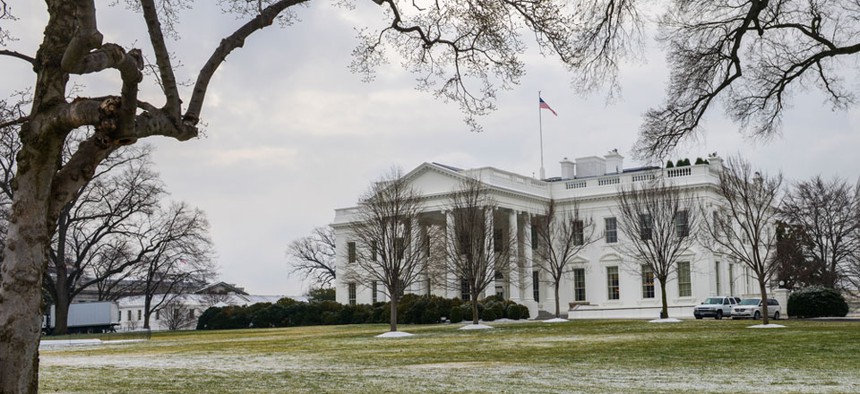
Orhan Cam/Shutterstock.com
Obama’s Management Goals Focus on Federal Employee Engagement
Other priorities include IT, strategic sourcing and evidence-based performance metrics.
The White House on Monday released a batch of documents that flesh out last week’s fiscal 2015 budget, spelling out a new set of agency-specific priorities and broader cross-agency goals.
To comply with the 2010 Government Performance and Results Modernization Act, the Obama administration outlined about 80 two-year agency goals dispersed across the major 24 agencies, ranging from the Agriculture Department’s strategic goal of ensuring that national forests and private working lands are “conserved, restored, and made more resilient to climate change” to the Social Security Administration’s priority of improving and strengthening its information technology.
Obama’s 15 four-year cross-agency priority goals are grouped by those oriented to mission and those oriented to management. The seven mission-related cross agency goals address cybersecurity; climate change; insider threats to agencies and security clearances; job creation; infrastructure permitting modernization; education in science, technology, engineering and math; and service disabilities and veterans’ mental health.
Eight management-oriented goals are each grouped under one of four themes: effectiveness, efficiency, economic growth and people and culture. These goals address customer service; smarter IT delivery; strategic sourcing; shared agency services; an effort to benchmark and improve mission-supported operations; open data; research programs that expedite technology from lab to market; and initiatives affecting federal people and agency culture.
“The new goals were selected based on their importance in accelerating economic growth, expanding opportunity, and ensuring the nation’s long-term fiscal strength,” wrote Beth Cobert, deputy director for management at the Office of Management and Budget, in a blog. They were chosen from nominations from federal agencies and several congressional committees, she said. Progress will be reported quarterly on Performance.gov, and “this spring, goal teams will release detailed implementation plans with specific metrics and milestones for cross-agency priority goals,” Cobert wrote.
For example, a workforce-related governmentwide goal -- the people and culture initiative -- is being led by Jonathan McBride, director of the Presidential Personnel Office, and Katherine Archuleta, director of the Office of Personnel Management. It will focus on employee engagement as “measured by employee views about their leaders, supervisors, and work experience,” with OMB noting that agencies can now get access to such data for more than “13,000 work-level units across the country (up from just a few hundred units four years ago).”
The strategic sourcing cross agency priority goal aims to build on the success of the Federal Strategic Sourcing Initiative that OMB says has saved $300 million since 2010 on commonly-purchased goods and office supplies through negotiating price reductions and avoiding duplication. It will be led by Lesley Field, acting administrator of the Office of Federal Procurement Policy, and Frank Kendall, undersecretary of Defense for acquisition, technology and logistics, who are tasked with expanding strategic sourcing in 2014 to other commodity areas such as janitorial and sanitation supplies, information technology, hardware and desktop publishing.
In the fiscal 2015 budget’s Analytical Perspectives, released Monday, the White House stressed that programs increasingly should be evaluated through hard evidence. Examples of past successes cited include the Treasury Department’s priority goal of increasing electronic transactions, which saves money and helps reduce fraud. Modernization of benefits systems “resulted in paper benefit payments dropping from 131 million in 2010 to 39 million in 2013, allowing Treasury to get money to beneficiaries and back into the economy faster than ever,” OMB wrote. “At the same time, electronic collections jumped from 85 percent of total collections in 2010 to 97 percent in 2013.”
Monday’s release of the varied goals and agency strategic plans marks “a big and important day in that GPRA is going live for the first time,” said Jitinder Kohli, a director in Deloitte’s public sector practice who headed the Doing What Works project for the liberal-leaning Center for American Progress. Overall, he found the new agency goals “significantly stronger than before,” citing the goals of decreasing the number of high schools with low graduation rates, curbing more greenhouse gas emissions, reducing tobacco use by 12 percent, and reducing the portion of airline passengers who are screened by the Transportation Security Administration. “These are all about the federal government making the world a better place on things that really matter to the American people, real-world results,” he said.
A few goals, he added, are less precise and simply move in the right direction, including those addressing violent crime, which focus on “collecting records and computer communication.” OPM’s diversity goal is also broad, Kohli said, focusing more on process. “But the ratio of good ones to less good ones has gotten better ever since the first goals were issued after President Obama was first elected,” he said. Agencies’ progress reporting in meeting their goals, Kohli said, is not as transparent as he thinks it could be. “Performance.gov is still a work in progress.”
The push for greater use of data metrics and evidence means agencies may count on help from at least two agencies whose budgets the Obama administration wants to increase. Under the president’s fiscal 2015 budget, the Government Accountability Office would receive $525 million, an increase of 3.9 percent, to boost its staff and improve infrastructure such as information technology, the agency reported last week. In calendar year 2014, GAO plans to enhance efforts to increase its staff for the first time in three years to 2,945 full-time employees.
Also, the Census Bureau has been slated by Obama for a $1.211 billion budget, a 28 percent increase from fiscal 2014 as calculated by the Census Project, an advocacy group. Some in Congress last year sought to eliminate some of the bureau’s economic surveys because they regarded them as intrusive.
(Image via Orhan Cam/Shutterstock.com)







